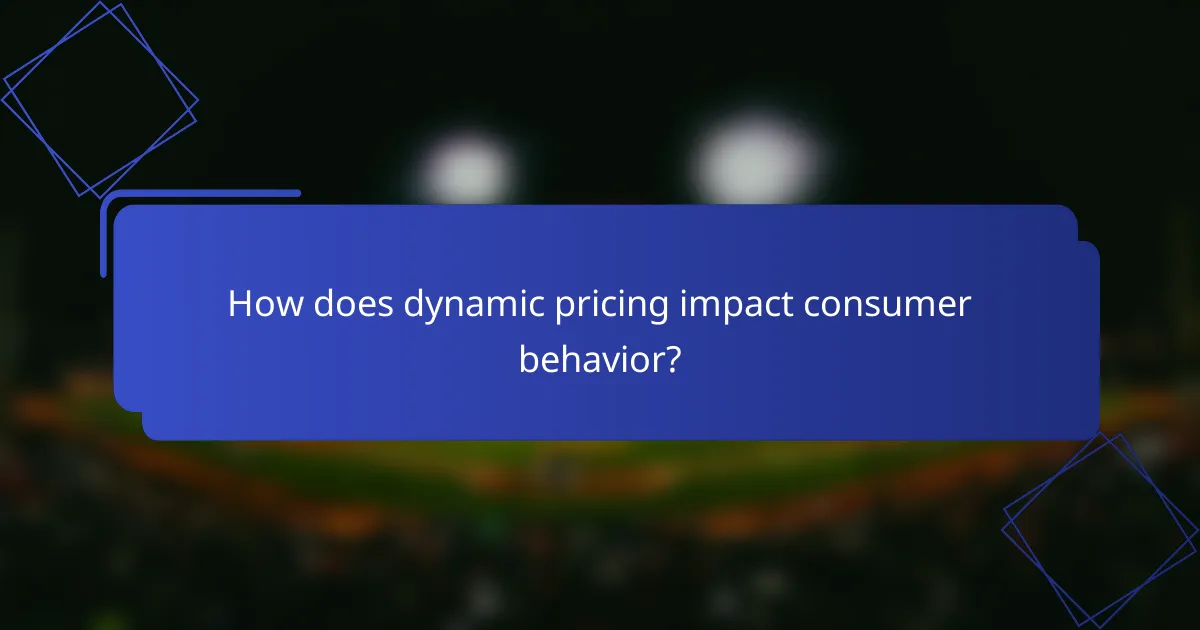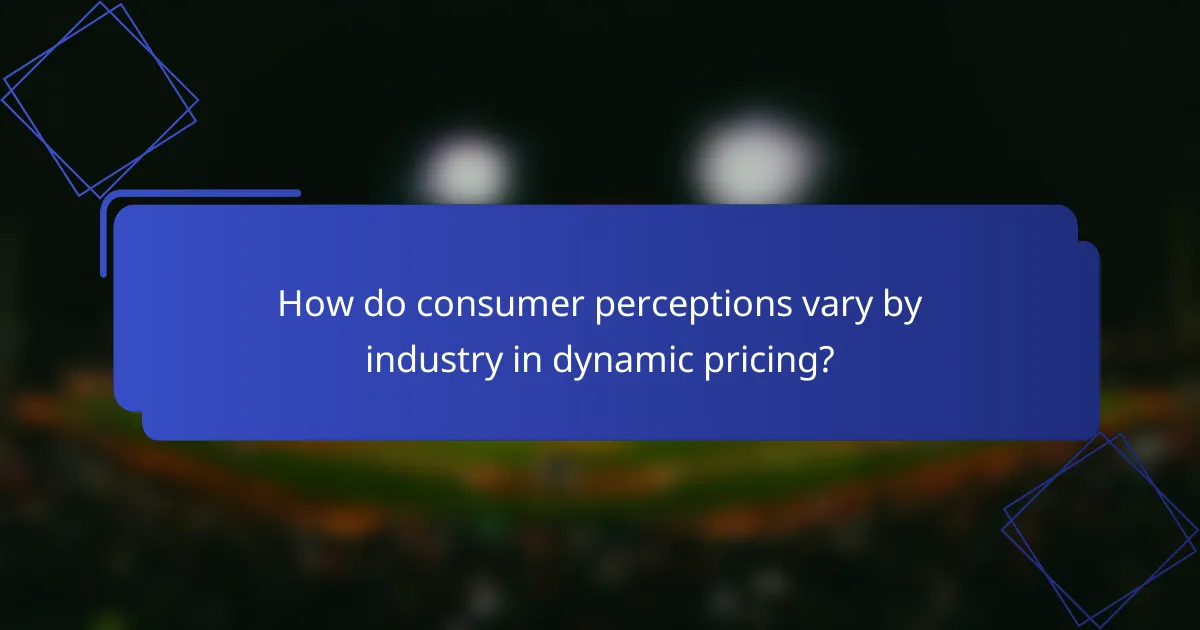Dynamic pricing is a powerful strategy that significantly impacts consumer behavior by influencing purchasing decisions through fluctuating prices. By employing techniques such as real-time data analysis and competitor monitoring, businesses can adjust prices to align with market conditions and consumer sensitivity, ultimately enhancing profitability and customer relationships.

How does dynamic pricing impact consumer behavior?
Dynamic pricing significantly influences consumer behavior by altering their purchasing decisions based on fluctuating prices. When prices change frequently, consumers may become more aware of price variations, leading to increased price sensitivity and strategic buying habits.
Increased price sensitivity
Dynamic pricing often heightens consumers’ sensitivity to price changes, prompting them to compare prices more actively across different platforms. This increased awareness can lead to a more cautious approach to spending, where consumers may delay purchases in anticipation of better deals.
For example, in industries like travel and hospitality, consumers frequently check prices for flights or hotel rooms, adjusting their buying behavior based on perceived value. This can result in a more competitive market, where businesses must continuously monitor and adjust their pricing strategies to retain customers.
Perceived fairness and trust issues
When consumers encounter dynamic pricing, they may question the fairness of the pricing strategy, especially if they feel they are being charged more than others for the same product. This perception can erode trust in a brand, leading to negative sentiments and potential loss of customer loyalty.
To mitigate these concerns, businesses should communicate their pricing strategies transparently and ensure that customers understand the reasons behind price fluctuations. For instance, explaining that prices vary based on demand or availability can help consumers feel more comfortable with the pricing model.
Influence on purchase timing
Dynamic pricing can significantly affect when consumers choose to make a purchase. With prices changing based on demand, consumers may time their purchases to coincide with lower prices, leading to strategic buying behavior.
For example, during peak seasons, consumers might wait for promotional offers or discounts before booking travel or making significant purchases. Retailers can leverage this behavior by offering limited-time discounts or flash sales, encouraging consumers to act quickly while still maximizing revenue during high-demand periods.

What strategies can businesses use for dynamic pricing?
Businesses can employ several strategies for dynamic pricing, including real-time data analysis, competitor price monitoring, and customer segmentation. These approaches allow companies to adjust prices based on market conditions, consumer behavior, and competitive landscape.
Real-time data analysis
Real-time data analysis involves continuously monitoring various data points, such as demand fluctuations, inventory levels, and customer purchasing patterns. By leveraging advanced analytics tools, businesses can make immediate pricing adjustments to maximize revenue and respond to market changes.
For example, an airline might increase ticket prices during peak travel seasons based on real-time booking data. Companies should ensure they have robust data collection systems in place to support effective real-time analysis.
Competitor price monitoring
Competitor price monitoring entails keeping track of competitors’ pricing strategies to remain competitive in the market. Businesses can use automated tools to gather pricing information from competitors and adjust their own prices accordingly.
For instance, an online retailer may lower prices on specific products if a competitor offers a discount. Regularly analyzing competitor prices helps businesses avoid losing customers to better-priced alternatives while maintaining profitability.
Customer segmentation
Customer segmentation involves categorizing customers based on their behavior, preferences, and willingness to pay. By understanding different customer segments, businesses can tailor their pricing strategies to meet specific needs and maximize sales.
For example, a subscription service might offer different pricing tiers based on usage levels or customer loyalty. This approach allows companies to capture more value from customers who are willing to pay more while still attracting price-sensitive buyers.

What are the benefits of dynamic pricing for retailers?
Dynamic pricing offers retailers the ability to adjust prices in real-time based on market demand, competition, and other factors. This strategy can lead to increased profitability, better inventory control, and stronger customer relationships.
Maximized revenue potential
Dynamic pricing allows retailers to optimize their pricing strategies to capture maximum revenue. By analyzing customer behavior and market trends, businesses can set prices that reflect what consumers are willing to pay at any given time.
For example, during peak shopping seasons or special events, prices can be increased to take advantage of heightened demand. Conversely, during slower periods, discounts can be offered to stimulate sales, ensuring that revenue remains consistent throughout the year.
Improved inventory management
With dynamic pricing, retailers can better manage their inventory levels by adjusting prices based on stock availability. When inventory is high, prices can be lowered to encourage sales, while low stock levels can justify higher prices.
This approach helps prevent overstock situations and reduces the risk of markdowns on unsold items. Retailers can use data analytics to forecast demand and adjust prices accordingly, ensuring that inventory turnover remains healthy.
Enhanced customer engagement
Dynamic pricing can lead to improved customer engagement by providing personalized pricing based on individual shopping behavior. Retailers can offer tailored discounts or promotions to specific customer segments, increasing the likelihood of conversion.
Additionally, transparent pricing strategies can foster trust and loyalty among consumers. By clearly communicating the reasons behind price changes, retailers can enhance the shopping experience and encourage repeat business.

What challenges do businesses face with dynamic pricing?
Businesses encounter several challenges with dynamic pricing, including technology integration, customer backlash, and legal and ethical considerations. These hurdles can significantly impact the effectiveness and acceptance of dynamic pricing strategies.
Technology integration issues
Implementing dynamic pricing requires sophisticated technology systems that can analyze vast amounts of data in real-time. Many businesses struggle with integrating these systems into their existing infrastructure, leading to inefficiencies and potential errors in pricing.
Additionally, companies must ensure that their pricing algorithms are accurate and responsive. This often involves continuous testing and adjustments, which can be resource-intensive and complex.
Customer backlash
Dynamic pricing can lead to customer dissatisfaction, especially if consumers perceive prices as unfair or inconsistent. For example, if a customer buys a product only to see its price drop shortly after, they may feel cheated and lose trust in the brand.
To mitigate backlash, businesses should communicate their pricing strategies clearly and offer price guarantees or refunds in certain situations. Transparency can help maintain customer loyalty and reduce negative perceptions.
Legal and ethical considerations
Dynamic pricing must navigate various legal and ethical challenges, including price discrimination and compliance with consumer protection laws. Businesses need to ensure that their pricing strategies do not unfairly target specific groups or violate regulations.
Moreover, ethical concerns arise when dynamic pricing leads to significant disparities in pricing for similar products. Companies should establish guidelines to ensure fairness and transparency in their pricing practices, which can help build consumer trust and avoid legal repercussions.

How do consumer perceptions vary by industry in dynamic pricing?
Consumer perceptions of dynamic pricing differ significantly across industries, influenced by factors such as value perception, transparency, and competition. In sectors like travel and hospitality, consumers may accept price fluctuations due to limited availability, while in e-commerce, they often expect stable pricing and may react negatively to sudden changes.
Travel and hospitality sector
In the travel and hospitality sector, dynamic pricing is commonly accepted due to the nature of the industry. Airlines and hotels frequently adjust prices based on demand, time of booking, and occupancy rates. For example, prices for flights can vary widely depending on the season, day of the week, and how close the booking date is to the departure.
Consumers often anticipate these fluctuations, especially during peak travel seasons. However, transparency is crucial; if customers feel misled about pricing, it can lead to dissatisfaction. Offering clear explanations for price changes can help mitigate negative perceptions.
E-commerce and retail sector
In e-commerce and retail, consumer reactions to dynamic pricing can be more volatile. Shoppers generally prefer consistent pricing and may view frequent changes as unfair or manipulative. For instance, if a product’s price increases shortly after they add it to their cart, it can lead to frustration and cart abandonment.
To navigate this, retailers should consider implementing price guarantees or notifying customers of price drops post-purchase. This approach can build trust and encourage repeat business. Additionally, using data analytics to understand consumer behavior can help retailers optimize their pricing strategies without alienating customers.



